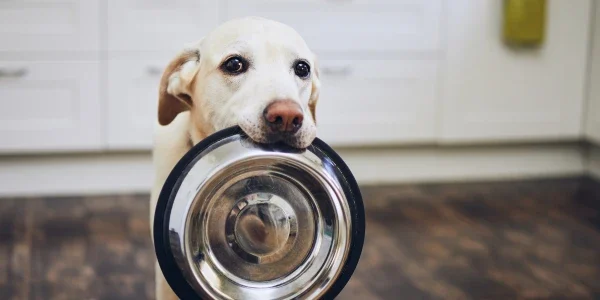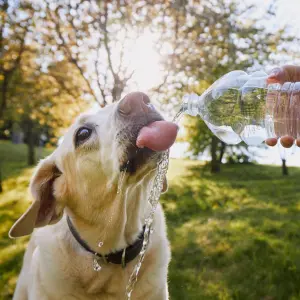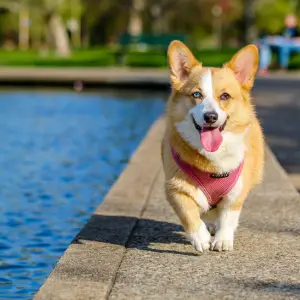Dog Water Bowl Tips
As a responsible dog owner, ensuring your canine companion stays properly hydrated is crucial for their overall health and well-being. One key aspect of promoting hydration is selecting the right water bowl. In this article, we’ll discuss important dog water bowl tips that will help you provide a clean, accessible, and suitable water source for your furry friend. By implementing these tips, you can encourage regular water intake and support their hydration needs effectively.

The Importance of a Proper Dog Water Bowl
When it comes to promoting hydration in dogs, the water bowl plays a significant role. A proper water bowl provides a clean and accessible water source for your dog, encouraging them to drink regularly. By ensuring your dog has a suitable water bowl, you support their overall health and well-being, as proper hydration is crucial for maintaining organ function, regulating body temperature, and promoting optimal bodily processes.
Choosing the Right Dog Water Bowl:
Material Considerations
When selecting a dog water bowl, consider the material carefully. Here are some key points to consider:
- Stainless Steel: Stainless steel bowls are durable, easy to clean, and resistant to bacterial growth. They are also non-porous, which helps prevent the buildup of odors or stains. Choose high-quality stainless steel bowls that are free from harmful chemicals like lead or BPA.
- Ceramic: Ceramic bowls are sturdy and come in various designs. They are less prone to scratches and can retain coolness, which can be beneficial during hot weather. However, ensure the ceramic bowl is lead-free and glazed properly to avoid any potential health risks.
- Plastic: Plastic bowls are lightweight and often more affordable. However, it’s essential to choose BPA-free options to avoid any potential harmful effects of chemicals leaching into the water. Plastic bowls may develop scratches over time, which can harbor bacteria, so regular cleaning is crucial.
- Silicone: Silicone bowls are collapsible, making them convenient for travel or storage. They are typically made from food-grade silicone, which is safe for dogs. Silicone bowls are easy to clean and often dishwasher-safe. However, ensure the silicone bowl is sturdy enough to prevent tipping or spilling.
Consider your dog’s needs and preferences, as well as factors such as durability, ease of cleaning, and safety when choosing the material for your dog’s water bowl.
Size and Capacity
The size and capacity of the water bowl are crucial for meeting your dog’s hydration needs. Here are some factors to consider:
- Breed and Size: Different dog breeds and sizes have varying water requirements. Larger breeds generally need larger water bowls, while smaller breeds may suffice with smaller bowls. Consider your dog’s size and water consumption habits to choose an appropriately sized bowl.
- Water Consumption: Observe your dog’s water intake over a few days to gauge their average consumption. This will help you determine the capacity of the water bowl. A general guideline is to provide approximately one ounce of water per pound of body weight per day. However, factors such as weather, activity level, and health conditions can influence water intake, so monitor your dog’s individual needs.
- Continuous Water Supply: Choose a bowl with a capacity that ensures a continuous supply of fresh water throughout the day. This helps prevent frequent refills and ensures your dog always has access to water, especially during hot weather or active periods.
Consider your dog’s specific requirements and adjust the size and capacity of the water bowl accordingly to support their hydration needs.
Stability and Tip-Resistance
Stability and tip-resistance are important considerations, especially for energetic or large dogs. Here’s what to look for:
- Wide Base: Choose a water bowl with a wide base that provides stability. This prevents the bowl from easily tipping over or sliding around while your dog drinks.
- Non-Slip Bottom: Look for a bowl with a non-slip bottom to provide additional stability on smooth surfaces. This helps prevent accidental spills and messes.
- Weighty Construction: Consider bowls made of heavier materials or those with added features that enhance stability. Weighted bowls are less likely to be pushed or flipped over, even by more enthusiastic drinkers.
By selecting a water bowl with adequate stability and tip-resistance, you ensure that your dog can drink comfortably without disruptions, spills, or accidents.
When choosing the right water bowl for your dog, consider the material’s durability, ease of cleaning, and safety. Additionally, select a size and capacity that meet your dog’s hydration needs, and prioritize stability and tip-resistance to prevent spills and messes. By carefully considering these factors, you can choose a water bowl that supports your dog’s hydration and overall well-being effectively.
Water Bowl Placement and Maintenance
Location and Accessibility
Proper placement of the water bowl and ensuring its accessibility are crucial for your dog’s convenience and hydration. Consider the following points:
- Quiet Area: Choose a location for the water bowl that is away from high-traffic zones and noise. Dogs prefer a calm and quiet environment when drinking water.
- Separate from Food: Keep the water bowl separate from the food bowl. Dogs instinctively avoid drinking water that is near their food, as it may become contaminated with food particles. Placing the water bowl in a different area helps ensure clean and fresh water.
- Multiple Water Stations: If you have a multi-dog household or a large living space, consider providing multiple water stations. This ensures that each dog has easy access to water, regardless of their location. It also helps prevent dominance-related issues or conflicts over the water bowl.
- Accessible Height: Ensure the water bowl is at an appropriate height for your dog. Consider their size and height, and choose a bowl that allows them to drink comfortably without straining their neck or bending too low. Elevated bowls may be beneficial for larger dogs or those with joint or mobility issues.
By strategically placing the water bowl in a quiet area, separate from the food bowl, and ensuring accessibility for your dog’s size, you promote their convenience and encourage regular water intake.
Regular Cleaning and Hygiene
Regular maintenance and cleaning of the water bowl are essential to provide a clean and safe drinking experience for your dog. Here are some tips:
- Daily Cleaning: Rinse the water bowl with warm water and mild detergent daily. This helps remove any residual dirt or particles.
- Weekly Deep Cleaning: Once a week, give the water bowl a thorough cleaning. Use a pet-safe disinfectant or vinegar solution to eliminate bacteria or odors. Rinse the bowl thoroughly to remove any cleaning agents.
- Scrubbing and Soaking: Scrub the bowl with a gentle brush or sponge to remove any stubborn stains or buildup. Soak the bowl in a mixture of vinegar and warm water for a few minutes to further disinfect it.
- Drying: After cleaning, ensure the water bowl is completely dry before refilling it. Moisture can promote bacterial growth, so proper drying is essential.
- Regular Inspections: Regularly inspect the water bowl for any signs of wear, cracks, or damage. Replace the bowl if needed to ensure your dog’s safety and hygiene.
By maintaining a regular cleaning schedule and ensuring the water bowl is free from bacteria or contaminants, you provide your dog with a clean and safe drinking environment.
Proper placement and regular maintenance of the water bowl contribute to your dog’s convenience, hygiene, and overall hydration. By strategically placing the water bowl in a quiet area, separate from the food bowl, and ensuring accessibility, you promote your dog’s convenience and encourage regular water intake. Additionally, by implementing a regular cleaning routine, you ensure a clean and safe drinking experience for your furry friend.
Travel-Friendly Options
Consider travel-friendly water bowl options for outings or trips with your dog. These compact and lightweight options allow you to provide water for your dog wherever you go, ensuring they stay hydrated even when away from home.
- Collapsible Bowls: Collapsible water bowls are a popular choice for travel. These bowls are made of flexible materials like silicone or fabric that can be easily collapsed or folded when not in use. They are lightweight and compact, making them convenient to carry in your bag or attach to a leash. When needed, simply expand the bowl, fill it with water, and offer your dog a drink. Collapsible bowls are easy to clean and often dishwasher-safe, making them ideal for travel.
- Portable Water Dispensers: Portable water dispensers are specifically designed to hold and dispense water for dogs on the go. These containers typically feature a storage compartment for water and a built-in bowl or spout for easy access. Some dispensers have a flip-open design or a squeeze bottle mechanism that allows you to control the water flow. Portable water dispensers are lightweight, leak-proof, and convenient for outings, hikes, or road trips. They ensure your dog has access to water whenever they need it, without the need for a separate bowl.
- Water Bottle with Bowl Attachment: Another option is a water bottle with a bowl attachment. These bottles usually have a detachable bowl that screws onto the top or acts as a cap. When you’re ready to offer your dog water, simply unscrew the bowl, fill it with water from the bottle, and let your dog drink. This two-in-one design eliminates the need for carrying a separate bowl and water container. Look for bottles with leak-proof seals and a sturdy bowl attachment for reliable use during your travels.
- Disposable or Biodegradable Bowls: For short trips or situations where carrying a bowl is not practical, consider disposable or biodegradable bowls. These bowls are made from eco-friendly materials like paper or plant-based fibers. They are lightweight and can be easily discarded after use. Disposable or biodegradable bowls are available in various sizes and are an environmentally conscious option for providing water to your dog while on the go.
Conclusion
Choosing the right water bowl for your dog is essential for promoting hydration and overall well-being. By considering material options, size and capacity, stability, and proper placement, you can provide a clean, accessible, and suitable water source for your furry friend. Regular cleaning and maintenance ensure that the water bowl remains hygienic. Additionally, travel-friendly options and specialized bowls offer convenience and cater to specific needs. By implementing these dog water bowl tips, you prioritize your dog’s hydration and contribute to their overall health and happiness.
For more valuable information on dog care, hydration, and well-being, visit our website. Sign up for our newsletter to receive regular updates and tips on keeping your dog properly hydrated. Share this article with fellow dog owners to spread awareness about the importance of a proper water bowl and hydration. Together, let’s provide the best care for our beloved canine companions.



